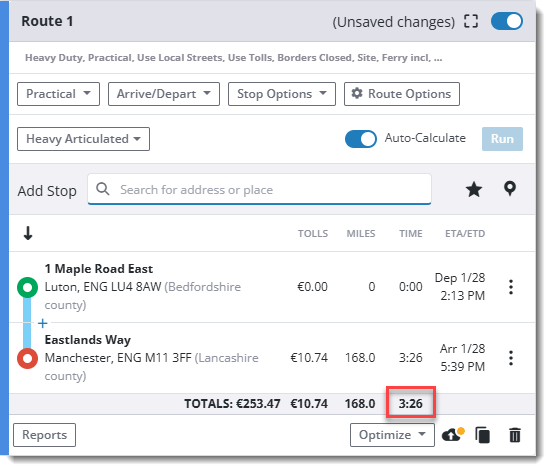Estimated Travel Time
Contents
Shippers and carriers rely on Trimble to not only plan safe and legal routes for commercial vehicles, but also to calculate accurate Estimated Travel Time (ETT) for those routes.
This article describes how our applications calculate ETT, as well as the options available to get the most precise times.

Road speeds and ETT
Road speeds, which are the average rate of travel along a road link, are the key to calculating ETT in all of our products. (Road speeds are not to be confused with speed limits, which are primarily used to inform drivers in CoPilot.)
To compute the ETT of a trip, our routing algorithm considers each link the route passes over. For each link it:
- Chooses a road speed type and value.
- Gets the length of that link.
- Computes time spent on that link.
- Adds that time to the overall sum of travel time.
Step 1, choosing a road speed type and value, is where the greatest variation occurs in how ETT is calculated.
Road speed types
The routing algorithm may use one of two sources of road speed information:
- Live traffic and Historic traffic. These speeds are obtained from 3rd party providers: Inrix in the U.S. and Canada, and HERE in Europe and the rest of the world.
- Default Trimble speeds (formerly called ALK road speeds).
In general, default speeds are used if your application is not licensed for traffic. However, our products offer the ability to toggle traffic data on or off.
Live and historic traffic
Live speeds refer to real-time traffic speeds, and are only available with an Internet connection. Their impact on ETT is detailed here.
Historic speeds are average speeds per road link, with four time buckets per hour. (A total of 96 time buckets per day, per link.) Historic speeds are included with our map data, and do not require an Internet connection for products that can otherwise be used offline.
Default road speeds
Default speeds are set per vehicle type, per road class, per urban/rural, and per state/county.
These speeds are intended as the average speed for a given road type, when taking into account likely speed limits, traffic and potential stop signs and traffic lights.
The defaults are based on Trimble’s more than four decades of knowledge and research for state/country specific speeds for the Truck vehicle type.
Choosing a speed type
The speed used for any given link when computing ETT depends on a number of things.
- Is the product licensed for traffic data? Traffic data is licensed separately in all applications.
- Is the traffic service enabled? The traffic service can be toggled on/off in all products. Depending on the product, traffic may be on or off by default.
- Has a departure time been specified? If the departure time is within 15 minutes of the current time, real-time traffic data will be used for the first 15 miles and historical traffic patterns will be used for the remainder of the route.
- Is a time or day of the week specified? Historic information differs by day and time. If no time is specified, Historic reference traffic speeds are used.
Speed hierarchy
The table below defines the hierarchy used to determine what speed is used for any given link:
| Speed Type | Traffic Licensed | Traffic Enabled | Arrive/Depart Time |
|---|---|---|---|
| Live | Yes | Yes | Current time |
| Historic | Yes | Yes | Specific time + (date/day of week) |
| Historic Reference (i.e. Base) | Yes | Yes | Only date or day of week, no time |
| Default Speeds | No | No | None |
Road speed limiters
The algorithm may employ additional mechanisms to cap road speeds to ensure ETT aligns more closely with the realistic driving speeds of larger vehicles. Initially, the algorithm determines the road speed based on the hierarchy outlined in the table above. It then compares this speed against various limiters, selecting the lowest value. Limiters include:
-
Governor speed: All products have a governor speed trip option that acts as the ceiling speed any time road speed data is used for ETT calculation. By default, the governor speed is 0, which disables the feature.
-
Jurisdiction-Wide Rules (JWR): Some U.S. states and European countries have JWR speed limits for trucks that are different from auto speed limits. These can also act as a speed limiter under the following conditions:
- The trip vehicle type is Truck, Midsize Truck or Bus.
- The previous speed type is Live or Historic Traffic.
- JWR speed limits exist in the state/country of the link and for the given vehicle configuration.
ETT and ETA calculations
While ETT accounts for travel time, our applications also offer various options and settings that use ETT to calculate accurate ETAs for each stop on a route. These options include:
- Setting an arrival or a departure time.
- Adding stop durations (dwell time) for work or rest stops.
- Calculating required breaks to comply with Hours of Service (HOS) rules.
- Optimizing routes to meet time windows.
All of those factors, and more, can be taken into account for ETA calculations using our Trip Management service.
Share this article: